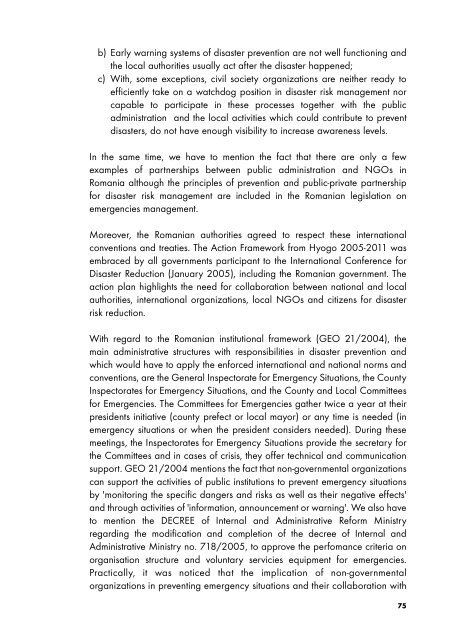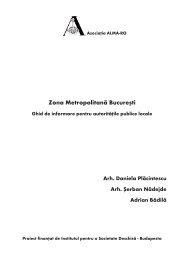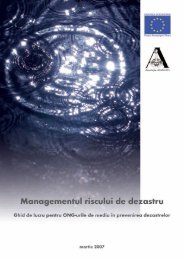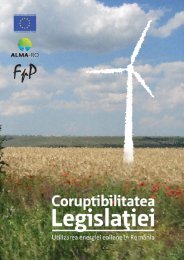Reþeaua ONG pentru Prevenirea Dezastrelor - Asociaţia ALMA-RO
Reþeaua ONG pentru Prevenirea Dezastrelor - Asociaţia ALMA-RO
Reþeaua ONG pentru Prevenirea Dezastrelor - Asociaţia ALMA-RO
Create successful ePaper yourself
Turn your PDF publications into a flip-book with our unique Google optimized e-Paper software.
) Early warning systems of disaster prevention are not well functioning and<br />
the local authorities usually act after the disaster happened;<br />
c) With, some exceptions, civil society organizations are neither ready to<br />
efficiently take on a watchdog position in disaster risk management nor<br />
capable to participate in these processes together with the public<br />
administration and the local activities which could contribute to prevent<br />
disasters, do not have enough visibility to increase awareness levels.<br />
In the same time, we have to mention the fact that there are only a few<br />
examples of partnerships between public administration and NGOs in<br />
Romania although the principles of prevention and public-private partnership<br />
for disaster risk management are included in the Romanian legislation on<br />
emergencies management.<br />
Moreover, the Romanian authorities agreed to respect these international<br />
conventions and treaties. The Action Framework from Hyogo 2005-2011 was<br />
embraced by all governments participant to the International Conference for<br />
Disaster Reduction (January 2005), including the Romanian government. The<br />
action plan highlights the need for collaboration between national and local<br />
authorities, international organizations, local NGOs and citizens for disaster<br />
risk reduction.<br />
With regard to the Romanian institutional framework (GEO 21/2004), the<br />
main administrative structures with responsibilities in disaster prevention and<br />
which would have to apply the enforced international and national norms and<br />
conventions, are the General Inspectorate for Emergency Situations, the County<br />
Inspectorates for Emergency Situations, and the County and Local Committees<br />
for Emergencies. The Committees for Emergencies gather twice a year at their<br />
presidents initiative (county prefect or local mayor) or any time is needed (in<br />
emergency situations or when the president considers needed). During these<br />
meetings, the Inspectorates for Emergency Situations provide the secretary for<br />
the Committees and in cases of crisis, they offer technical and communication<br />
support. GEO 21/2004 mentions the fact that non-governmental organizations<br />
can support the activities of public institutions to prevent emergency situations<br />
by 'monitoring the specific dangers and risks as well as their negative effects'<br />
and through activities of 'information, announcement or warning'. We also have<br />
to mention the DECREE of Internal and Administrative Reform Ministry<br />
regarding the modification and completion of the decree of Internal and<br />
Administrative Ministry no. 718/2005, to approve the perfomance criteria on<br />
organisation structure and voluntary servicies equipment for emergencies.<br />
Practically, it was noticed that the implication of non-governmental<br />
organizations in preventing emergency situations and their collaboration with<br />
75






